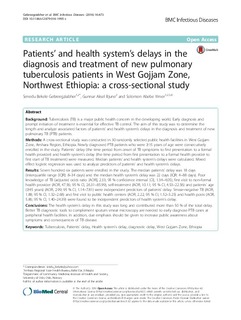| dc.description.abstract | Background Tuberculosis (TB) is a major public health concern in the developing world. Early diagnosis and prompt initiation of treatment is essential for effective TB control. The aim of this study was to determine the length and analyze associated factors of patients’ and health system’s delays in the diagnosis and treatment of new pulmonary TB (PTB) patients. Methods A cross-sectional study was conducted in 30 randomly selected public health facilities in West Gojjam Zone, Amhara Region, Ethiopia. Newly diagnosed PTB patients who were ≥15 years of age were consecutively enrolled in the study. Patients’ delay (the time period from onset of TB symptoms to first presentation to a formal health provider) and health system’s delay (the time period from first presentation to a formal health provider to first start of TB treatment) were measured. Median patients’ and health system’s delays were calculated. Mixed effect logistic regression was used to analyze predictors of patients’ and health system’s delays. Results Seven hundred six patients were enrolled in the study. The median patients’ delay was 18 days (interquartile range [IQR]: 8–34 days) and the median health system’s delay was 22 days (IQR: 4–88 days). Poor knowledge of TB (adjusted odds ratio [AOR], 2.33; 95 % confidence interval [CI], 1.34–4.05), first visit to non-formal health provider (AOR, 47.56; 95 % CI, 26.31–85.99), self-treatment (AOR, 10.11; 95 % CI, 4.53–22.56) and patients’ age (≥45 years) (AOR, 2.99; 95 % CI, 1.14–7.81) were independent predictors of patients’ delay. Smear-negative TB (AOR, 1.88; 95 % CI, 1.32–2.68) and first visit to public health centers (AOR, 2.22; 95 % CI, 1.52–3.25) and health posts (AOR, 5.86; 95 % CI, 1.40–24.39) were found to be independent predictors of health system’s delay. Conclusions The health system’s delay in this study was long and contributed more than 50 % of the total delay. Better TB diagnostic tools to complement sputum smear microscopy are needed to early diagnose PTB cases at peripheral health facilities. In addition, due emphasis should be given to increase public awareness about symptoms and consequences of TB disease. | |
